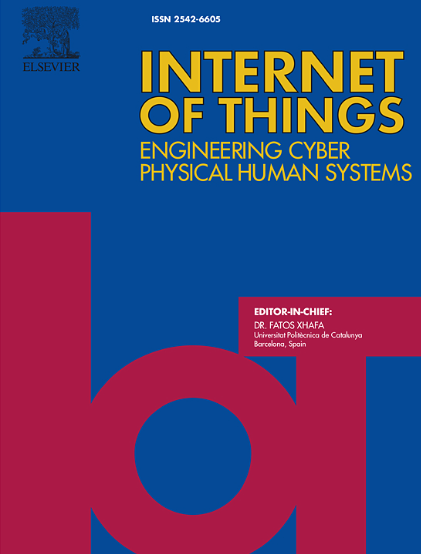IoT-HGDS:基于物联网集成机器学习的智能厨房有害气体检测系统
IF 6
3区 计算机科学
Q1 COMPUTER SCIENCE, INFORMATION SYSTEMS
引用次数: 0
摘要
本文提出了一种用于智能厨房的物联网(IoT)和机器学习(ML)集成式有害气体检测系统(IoT-HGDS)。该设计集成了六个锡氧化物基金属氧化物半导体(MOS)气体传感器阵列和一个 DHT22(温度和湿度传感器)。这种物联网-HGDS 可以检测厨房材料释放的不同有害气体、挥发性有机化合物(VOC)和气味反应,并通过亚马逊网络服务(AWS)实时传输到远程数据处理中心(RDPC)。在本实验中,我们从酥油、牛奶、液化石油气(LPG)、面包、芥末油、压缩天然气(CNG)、豌豆、精炼油和煤油等 9 种厨房用品中采集了 150×9=1350 个样本。标准化独立成分分析(SICA)预处理技术用于清理数据、标准化特征和去除异常值。逻辑回归(LR)、自适应提升(AdaBoost)和正则判别分析(RDA)等 ML 方法已被用于准确识别气体/VOC 类别,并提供即时警报,以提高厨房安全。与 LR 和 AdaBoost 相比,SICA-RDA 分类器在性能和均衡精度、召回率和 F1 分数方面表现更优(最高精度为 97.78%)。在所有指标中,LR 的性能最低。液化石油气的平均平方误差(MSE)最低,为 6.62×10-7,而压缩天然气的平均平方误差(MSE)最高,为 3.60×10-4。该系统可以智能地保存气体,确保安全防范措施,防止厨房事故的发生。本文章由计算机程序翻译,如有差异,请以英文原文为准。
IoT-HGDS: Internet of Things integrated machine learning based hazardous gases detection system for smart kitchen
This paper proposes an Internet of Things (IoT) and Machine Learning (ML) integrated Hazardous Gas Detection System (IoT-HGDS) for smart kitchens. The design incorporates six tin-oxide-based metal–oxide–semiconductor (MOS) gas sensor arrays and one DHT22 (temperature & humidity sensor). This IoT-HGDS can detect different hazardous gases, Volatile Organic Compounds (VOCs), and odors responses released from the kitchen’s materials and transmit them to a Remote Data Processing Centre (RDPC) through Amazon-Web Services (AWS) in real time. In this experiment, we collected samples from 9 kitchen materials like ghee, milk, liquid petroleum gas (LPG), bread, mustard oil, compressed natural gas (CNG), pigeon peas, refined oil, and kerosene. The Standardized Independent Component Analysis (SICA) pre-processing technique has been used to clean data, standardize the features, and remove outliers. ML approaches like Logistic Regression (LR), Adaptive Boosting (AdaBoost) and Regularized Discriminant Analysis (RDA) have been applied for accurate identification of gases/VOCs class and provide immediate alerts to improve kitchen safety. The SICA-RDA classifier outperformed (highest accuracy at 97.78 %) as compared to LR and AdaBoost in terms of performance and balanced precision, recall, and F1-Score. LR has the lowest performance in all metrics. LPG has the lowest Mean Squared Error (MSE) of , while CNG has the highest MSE of . This system can intelligently preserve gases, ensure safety precautions, and prevent accidents in the kitchens.
求助全文
通过发布文献求助,成功后即可免费获取论文全文。
去求助
来源期刊

Internet of Things
Multiple-
CiteScore
3.60
自引率
5.10%
发文量
115
审稿时长
37 days
期刊介绍:
Internet of Things; Engineering Cyber Physical Human Systems is a comprehensive journal encouraging cross collaboration between researchers, engineers and practitioners in the field of IoT & Cyber Physical Human Systems. The journal offers a unique platform to exchange scientific information on the entire breadth of technology, science, and societal applications of the IoT.
The journal will place a high priority on timely publication, and provide a home for high quality.
Furthermore, IOT is interested in publishing topical Special Issues on any aspect of IOT.
 求助内容:
求助内容: 应助结果提醒方式:
应助结果提醒方式:


